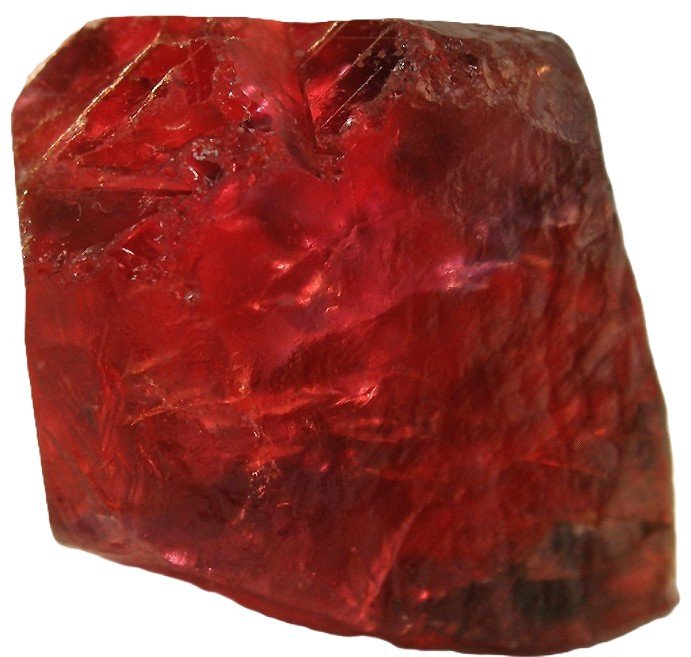
The name ruby comes from the Latin ruber, meaning “red”, the colour most associated with this striking gemstone. In ancient Sanskrit, it was called ratnaraj, or “king of precious stones”. Alternate names throughout history include carbuncle, an archaic term used in medieval Europe for glowing red gemstones. Rubies have often been referred to as the “stone of kings” for their regal symbolism and prominence in crowns and treasures.
Composition, Physical Characteristics, and Varieties
Ruby is the red variety of corundum, an aluminium oxide mineral. It owes its red hue to trace amounts of chromium. Rated 9 on the Mohs scale, ruby is one of the hardest natural gemstones, second only to diamond. Its colour ranges from pinkish-red to deep crimson, with the most prized shade known as pigeon blood red. Varieties include star rubies, displaying asterism (a star-like effect caused by needle-like inclusions of rutile), and translucent cabochon rubies often used in mystical jewellery.
Geographical Locations
Major sources of ruby include Myanmar (Burma), renowned for its exceptional pigeon blood rubies, as well as Sri Lanka, Thailand, Vietnam, Mozambique, and Madagascar. Historically, the Mogok Valley in Myanmar has produced some of the world’s most valuable rubies, while African deposits have become increasingly important in modern trade.
Archaeological and Significant Finds
Rubies have been mined and cherished for over 2,000 years. In Burma, rubies were traditionally offered to rulers as a symbol of loyalty. In ancient India, they adorned temples and were believed to protect warriors in battle. One of the most significant rubies is the Sunrise Ruby, a 25.59-carat Burmese stone that set auction records for its rarity and beauty. Historical accounts also note rubies in medieval crowns and jewellery of European royalty, symbolising power and protection.
Historical and Current Usage
Historically, rubies were worn by kings and nobles as talismans against misfortune and to signify wealth and authority. Warriors believed rubies made them invincible in battle. Today, rubies are highly prized in fine jewellery, particularly in rings, necklaces, and royal collections. Their durability also makes them suitable for watchmaking and ornamental use.
Interesting Facts
- Ruby is chemically identical to sapphire; the only difference lies in its red colouring.
- Some cultures believed rubies could boil water or glow with an internal fire.
- The Sunrise Ruby sold for over £22 million, making it one of the most expensive coloured gemstones ever.
- Inclusions within rubies, often called their “silk”, can enhance their beauty and indicate authenticity.
Folklore, Superstition, Legends, and Tales
Throughout history, rubies have been surrounded by awe and mysticism. Ancient Burmese warriors believed inserting rubies into their flesh made them invincible. In Indian lore, rubies were offerings to the god Krishna, believed to secure rebirth as an emperor. Medieval Europeans thought rubies could predict danger by darkening in colour. In folklore, rubies symbolised eternal flame, passion, and undying love.
Mystical Healing Properties
Rubies are regarded as stones of energy, courage, and passion. They are said to:
- Stimulate vitality and physical energy.
- Encourage motivation and confidence.
- Strengthen the heart and circulatory system.
- Inspire love, devotion, and commitment.
- Protect against exhaustion and psychic attack.
Astrology and Zodiac Links
In astrology, ruby is ruled by the Sun, embodying vitality, leadership, and strength. It is particularly linked with Leo, enhancing confidence, creativity, and courage. Rubies also benefit Aries and Sagittarius, resonating with their fiery nature and drive for success.
Chakra Connections
Rubies are associated with the Root Chakra (Muladhara) and the Heart Chakra (Anahata). They ground energy, promote stability, and boost passion for life. When placed on the heart, they are believed to open channels for love and compassion, strengthening emotional bonds.
Birthstone and Wedding Anniversary
Ruby is the birthstone for July, symbolising passion, protection, and prosperity. It is also the traditional gift for the 40th wedding anniversary, celebrating enduring love and fiery devotion in marriage.
Crystal Combinations: What Works and What to Avoid
Rubies harmonise well with crystals such as garnet for passion, citrine for abundance, and rose quartz for love. They also pair beautifully with clear quartz, amplifying their fiery energy. However, rubies may clash with very grounding stones like hematite or overly tranquil stones like blue lace agate, as these can dampen their vibrant, energising qualities.
